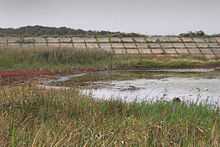Naze

The Naze is a headland on the east coast of England. It is on the coast of Essex just north of Blackwater and projects into the North Sea. This area is south of the double estuary of the River Stour and River Orwell at Harwich and just north of the town of Walton-on-the-Naze.
The Naze is a peninsula north of the town. It is important for migrating birds and it has a small nature reserve. The marshes of Hamford Water behind the town are also of ornithological interest, with wintering ducks and brent geese. Many Bird watchers visit at migration times.
Naze Tower
 | |
| Naze Tower | |
 | |
| Location | Near Walton-on-the-Naze, Essex, England |
|---|---|
| Coordinates | 51°52′08″N 1°16′46″E / 51.868966°N 1.279564°E |
| Year first constructed | 1720 |
| Construction | Brick |
| Tower shape | Octagonal |
| Height | 86 ft (26 m) |
The Hanoverian tower, more commonly known as the Naze Tower, is situated at the start of the open area of the Naze. It was a navigational tower, constructed to assist ships on this otherwise fairly feature-less coast. Visitors can climb the 111-step spiral staircase to the top of the 86-foot (26 m) tower for a 360 degree view of the beach and countryside. The Naze Tower features a museum with exhibits about the tower, the ecology and geology of the Naze, and the coastal erosion problem. The tower also features a private art gallery on six floors with changing exhibits several times a year, and a tea room. The tower is privately owned.
History of Naze Tower
The present tower was built in 1720-21 by Trinity House, and was intended to work in conjunction with Walton Hall Tower to guide vessels through the Goldmer Gap.[1] Towers at Naze and at Walton Hall are marked on a map of 1673 by Richard Blome, which in turn was based on a maps drawn up in the late 1500s.[2] The present Naze Tower therefore replaced an earlier construction at a similar location. It was of particular benefit to ships using the nearby port of Harwich. Both the current Naze Tower and its predecessor had beacons or lamps lit at the top, providing an early form of lighthouse.[3]
Over the years, the tower has had a variety of uses. In the Eighteenth Century it was a tea house, operated by the famous actress and aristocrats' mistress, Martha Raey. It was a lookout during the Napoleonic Wars and again during the Great War of 1914-18. In the Second World War it was used as a radar station, with its crenellations removed to accommodate a radar dish.[3]
Naze Tower was given Grade II* listed status in 1984 by English Heritage.[1] Since 1986, it has been in private ownership.[3]
Threats
The Naze is eroding rapidly and threatening the tower and the wildlife. The Naze Protection Society was formed to campaign for erosion controls. The Naze has become popular for school fieldwork into erosion and methods to protect the coast. Protection includes a sea wall, a riprap, groynes and a permeable groyne as well as drainage. Millions of tons of sand have been added to the beach to replenish it and stop the cliff eroding. However, the cliff near Naze Tower is greatly eroded. The cliff is receding fast and within 50 years Naze Tower may have tumbled into the sea like the pill boxes that can be seen on the beach.
Toponymy
The place-name "Naze" derives from Old English næss "ness, promontory, headland". In 1722 Daniel Defoe mentions the nearby town Walton calling it "Walton, under the Nase".[4]
Coordinates: 51°52′08″N 1°16′46″E / 51.868966°N 1.279564°E
Additional Photographs
-

Naze Tower
References
- ↑ 1.0 1.1 English Heritage. "British Listed Buildings". British Listed Buildings. Retrieved 31 March 2013.
- ↑ English Heritage. "British Listed Buildings: Tower at Walton Hall". British Listed Buildings. Retrieved 31 March 2013.
- ↑ 3.0 3.1 3.2 Nye-Browne, Michelle. Naze Tower: past, present and future. Walton on the Naze: Naze Tower.
- ↑ Daniel Defoe, A tour through England and Wales, J.M. Dent and Sons Ltd, London (1959) Available online here
External links
| Wikimedia Commons has media related to Naze Tower. |